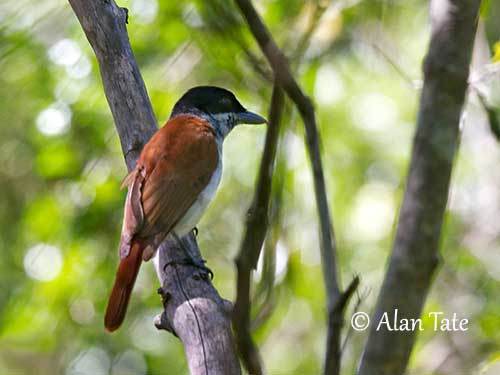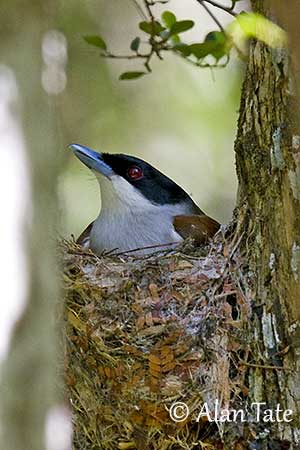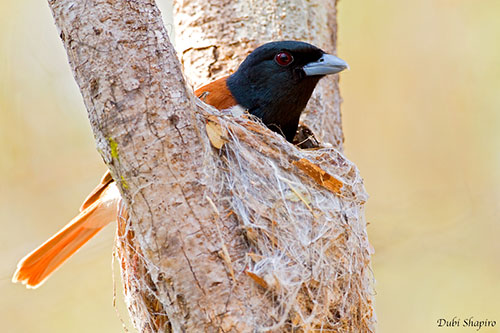
Fr: Schetbé roux
Ang: Rufous Vanga
All: Rotvanga
Esp: Vanga Rufo
Ita: Vanga rossiccia
Nd: Rosse Vanga
Sd: rostryggig vanga
Mal: patsatsatra, Poapoabava, Siketriala
Photographers:
William Price
PBase-tereksandpiper & Flickr William Price
Dubi Shapiro
Dubi Shapiro Photo Galleries & Dubi Shapiro's Pictures on IBC
Alan & Ann Tate
AA Bird Photography
Texte de Nicole Bouglouan
Sources :
HANDBOOK OF THE BIRDS OF THE WORLD Vol 14 by Josep del Hoyo-Andrew Elliot-David Christie - Lynx Edicions – ISBN: 9788496553507
Birds of Madagascar: A Photographic Guide Par Pete Morris, Frank Hawkins – ISBN: 0300077556, 9780300077551- Editeur: Yale University Press, 1998
Birds of Madagascar and the Indian Ocean Islands Par Roger Safford, Adrian Skerrett, Frank Hawkins – ISBN: 1472924118, 9781472924117- Editeur: Bloomsbury Publishing, 2015
The Birds of Africa: Volume VIII: The Malagasy Region: Madagascar, Seychelles, Comoros, Mascarenes - Par Roger Safford, Frank Hawkins – ISBN: 1408190494, 9781408190494- Editeur: A&C Black, 2013
Creagus – Bird Families of the World – Vangas - Vanginae
THE VANGAS OF MADAGASCAR by Nick Garbutt
Helping does not enhance reproductive success of cooperatively breeding rufous vanga in Madagascar
The Incubation and Hatching Patterns of the Rufous Vanga
Rufous Vanga
Schetba rufa
Passeriformes Order – Vangidae Family
INTRODUCTION:
The Rufous Vanga is endemic to Madagascar where it occurs in rainforest, mostly below 800 metres of elevation. It feeds on invertebrates and small vertebrates caught on branches and trunks, and on the forest floor.
It sings from the canopy in early morning and late afternoon, giving a variety of beautiful calls. They breed in the forest interior and build a nice nest in tree fork. The pair is helped by one or more immature males from the previous year.
The Rufous Vanga is generally common in primary western deciduous forest, and it is not globally threatened.
DESCRIPTION OF THE BIRD:
Biometrics:
Length: 20 cm
Weight: 30-44 g
The tri-coloured Rufous Vanga shows sexual dimorphism. The adult male has rufous upperparts, including upperwing-coverts. The primaries are dark brown with paler outer edges, whereas secondaries and tertials are brown with rufous tinge. The uppertail is rufous.
On the underparts, flanks, belly, undertail-coverts and underwing-coverts are white. The undertail feathers are pale rufous-brown.
The male’s head, throat and breast are glossy black with blue sheen.
The strong, broad bill is pale blue. The eyes are deep maroon-red. Legs and feet are blue-grey.

The adult female has black forehead, crown and nape, with grey collar on the latter. The cheeks are whitish. The upperparts are like in male.
On the underparts, chin and upper breast are whitish, fading to pale grey breast and flanks. Belly, undertail-coverts and underwing-coverts are white. The bare parts are like in male.
The juvenile resembles female but it has mostly dull brown wings and upperparts, while the tail is dull rufous. The breast is washed brown. The black of the head is mixed with dull brown. The eyes are dark brown. The bill is black with white tip.
The immature male (one year old) has black spots from neck to throat.
SUBSPECIES AND RANGE:
The Rufous Vanga has two subspecies.
S.r. occidentalis is found in W Madagascar. This one has slightly longer, heavier bill.
S.r. rufa occurs in N and E Madagascar.
HABITAT:
The Rufous Vanga occurs in eastern rainforest where it is patchily distributed in lowland forests. In the W, it frequents mostly areas of primary deciduous forest, and rarely occurs in degraded or open areas.
It favours forests with large trees and open understorey, and it can be common in this type of habitat, and in forest around sea-level. There are some records of this species up to 1,000 metres of elevation, but it occurs mainly below 800 metres.

CALLS AND SONGS: SOUNDS BY XENO-CANTO
The Rufous Vanga has varied and beautiful, wide repertoire. It gives descending, rippling trill “pipipiepepepepewpew, pew pew, whit-whitoo… whit-whitoo…, tuituituitui…”
We can also hear a loud, ringing “ti-ti-tong” with much lower third note. The female usually responds with “twit-twit-whit”
The alarm call is a nasal “ees” and ‘whip whip whip” or “kerekerekereh” accompanied by bill-snapping. The contact call is a quiet “whit” or “tew”
BEHAVIOUR IN THE WILD:
The Rufous Vanga feeds on a variety of invertebrates such as insects and worms, but it also takes small vertebrates including lizards, chameleons and geckos.
It hunts by sitting quietly for long periods, perched on low branch while looking for potential prey. They prey are caught on branches and trunks, but also among the leaf litter on the forest floor. It rarely forages in flight and feeds on the ground more often than other Vangidae. It forages by snatching, gleaning, performing short sallies or hovering too.
It is usually found in pairs, but often in family groups. It also joins mixed-species flocks.
During the breeding season, the breeding pair is sometimes assisted by one or more immature males of the previous year.

The Rufous Vanga usually breeds between the end of the dry season and the middle of the rainy season, from late September/mid-October to early/mid-January. Both mates incubate but later, while the female is brooding the chicks, the male provides almost all the food.
This species is monogamous. However, while the male is incubating as soon as the first egg is laid, the female forages and feeds, in order to form the following eggs. At this moment, she is often accompanied by a young male and may copulate with it if it is more than one year old. As the dominant male spends much time incubating, it is not able to guard its mate when she leaves the nest for feeding.
The helpers take part in territorial defence, mobbing of predators, and less often, in chick feeding.
The Rufous Vanga is sedentary and uses the same territory in successive years.
Like numerous vangas, it has short wings and only performs short-distance flights.
REPRODUCTION OF THIS SPECIES:
The breeding season takes place between October and January in NW of the island. The Rufous Vanga is a co-operative breeder. The breeding pair has one or more helpers, usually immature males of the previous year (1 or 2 years old). The territory is maintained both by pairs and helpers.

The female lays 4 white eggs with small chestnut and reddish spots. She lays one egg per day. Both adults incubate and the male starts the incubation after the first egg was laid. The incubation lasts 16 days (14-19 days). The chicks are brooded and fed by both parents, and sometimes by the helpers. The young fledge 15 days after hatching.
PROTECTION / THREATS / STATUS:
The Rufous Vanga is usually locally common in suitable forested habitat. The species is not globally threatened and is currently evaluated as Least Concern.
